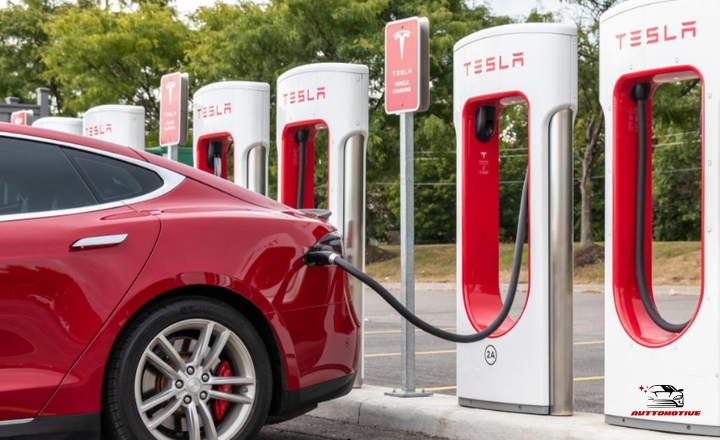Tesla charging stations are among the most advanced and innovative charging technologies available today. The technology behind them may seem complex, but the simple act of using one is remarkably straightforward. This writing will help you explore How Do Tesla Charging Stations Work and why these machines have become such a popular choice for electric vehicle owners. By understanding how a Tesla charging station converts energy from either an AC or DC power source into usable electricity, it is easy to see why so many people trust these machines with their vehicles.
So, you may wonder, How Do Tesla Charging Stations Work?

As Tesla focuses on electric vehicles, they have developed an extensive network of charging stations that are both easily identifiable and conveniently located across the country. These charging stations make it possible for Tesla owners to travel long distances without worrying about running out of power.
How Do Tesla Charging Stations Work?
Tesla charging stations are not your average electric vehicle charging stations. They are unique in that they use a proprietary connector for interoperability with Tesla vehicles. This means that only Tesla drivers can charge their cars at these stations, as the connector is not compatible with other EV models. This also enables faster and more efficient charging for Tesla owners.
Not only do Tesla charging stations offer speedy charging times, but they also come in two types: AC and DC. AC chargers provide power to the car’s onboard charger, which then converts it into DC power to charge the battery pack. DC chargers, on the other hand, bypass the onboard charger and directly supply DC power to the battery pack. As a result, DC chargers can charge Teslas much faster than AC ones.
Types Of Tesla Charging Stations
The two types of charging stations offered by Tesla include Superchargers and Destination chargers.
Superchargers
Superchargers are a game-changer in the world of electric vehicle charging. These high-powered charging stations are designed to rapidly charge Tesla vehicles, allowing drivers to travel long distances without worrying about running out of power. But not all Superchargers are created equal – there are actually several different types of Tesla charging stations that offer varying levels of power and convenience.
The most common type of Supercharger is the V3 Supercharger, which can deliver up to 250 kW of power to compatible Tesla vehicles. This allows for incredibly fast charging times – a Model S or Model X can add up to 200 miles of range in just 15 minutes. V3 Superchargers also feature liquid-cooled cables and chargers, as well as advanced software that optimizes charging for each individual vehicle.
Destination chargers
Destination chargers provide high-speed charging to Tesla owners while they shop, dine, or stay at various locations across the country. Destination chargers can be found at hotels, restaurants, malls, and other public places where people tend to spend an extended period of time.
There are two types of destination chargers: Level 2 AC Chargers and DC Fast Chargers. Level 2 AC Chargers use alternating current (AC) power to charge the car’s battery using a standard household outlet or a dedicated charging unit.
How To Use a Tesla Charging Station
One question many new Tesla owners have is how to use the charging stations.
Park Next To Charging Machine:
Pull up next to the charging machine in the charging station to easily and conveniently charge your electric vehicle. These stations are usually located in front of parking spots, allowing you to park neatly and securely while you charge. By parking next to the charging machine, you can ensure that your car is close enough for the cable to reach.
When choosing a charging station, it’s important to look for those with accessible machines that are easy to locate. Many stations have multiple machines so be sure to choose one where you can easily pull up and connect your car without having to navigate around other vehicles or obstacles.
Once parked, make sure that your car is turned off before plugging in the cable. This will ensure that there are no risks of electrical shocks or other potential hazards.
Plug-In Your Vehicle
Once you’ve found a suitable charging station and have inspected your power outlet, you’ll need to determine what type of plug-in connection you’ll require. There are three main types of plug-ins: CHAdeMO, CCS (Combined Charging System), and Tesla Supercharger. It’s important to know which one your vehicle uses so that you can ensure compatibility with the charging station.
Allow The Cable To Lock Into Place
To ensure that the cable locks into place securely, you need to take your time and make sure that everything lines up perfectly. The locking mechanism can be a bit finicky at times, so don’t rush through this process. Take an extra few seconds to check and double-check everything before walking away from the charger.
To ensure proper charging functionality, allow the cable to lock into place also helps prevent accidents or damage caused by loose cables.
Wait For The Charge To Complete
Waiting for your charge to complete ensures that your battery is fully charged and ready for use. A partial charge may leave you stranded if you’re relying on a certain range. Frequent partial charges can shorten the lifespan of your battery over time. So take the time to let it fully recharge.
Other than that, waiting for your charge allows time for any updates or maintenance tasks that need to be carried out during charging. Some electric vehicle models require software updates or cooling cycles during charging which are necessary for optimal performance and safety.
Unlocking the Cost of Using a Tesla Charging Station
The average cost per kWh for using a Tesla charging station is around 28 cents. This means that if you charge your car with 50 kWh of electricity, it will cost approximately $14 to fill up your battery. This price can vary depending on where you live and what type of charger you are using. For example, some states may have higher electricity rates than others which could increase the overall cost per kWh.
Where Are Tesla Charging Stations Located?

Tesla has strategically placed their charging stations all around America, making it easy to find one no matter where you are. They have installed them in cities and on highways, providing convenience for people who travel long distances or commute within urban areas. They have partnered with businesses to install chargers at malls, hotels, and other locations where drivers can take a break while their car charges up.
The placement of Tesla’s charging stations also reflects their commitment to sustainability and reducing carbon emissions.
Final Words
Tesla charging stations are an efficient and convenient way for Tesla drivers to keep their cars charged. Not only do they offer the convenience of fast charging, but they also enable drivers to make full use of their vehicles’ range capabilities. With high levels of safety and reliability, in addition to a wide variety of plans, Tesla charging stations provide a great option for those looking to charge their cars quickly and easily. I hope this read on “How Do Tesla Charging Stations Work” helps you. Do you want more? keep in touch with us. We will upload more useful material for you.
FAQs
What are Tesla charging stations?
Tesla charging stations are electric vehicle charging points that are specifically designed to charge Tesla vehicles. They provide a high-power connection that can charge a Tesla car in a fraction of the time it would take to charge on a standard home outlet.
Where can I find Tesla charging stations?
The most convenient way to find them is through the Tesla website or mobile app. Both will provide you with maps that show the locations of all nearby charging stations. You can search for “Tesla Supercharger” on your preferred mapping application and it should bring up a list of all nearby charging stations.
Do I need a special adapter to charge my Tesla at a Tesla charging station?
Yes, to charge your Tesla at a Tesla charging station, you will need a special adapter. The type of adapter you need depends on the type of charger you have. For example, if you have a Tesla Model X or S, you’ll need a NEMA 14-50 adapter. If you have a Tesla Model 3, then you’ll need either a NEMA 5-15 or NEMA 14-50 adapter. Make sure to check the manual for your specific model to determine which one is right for your car.

